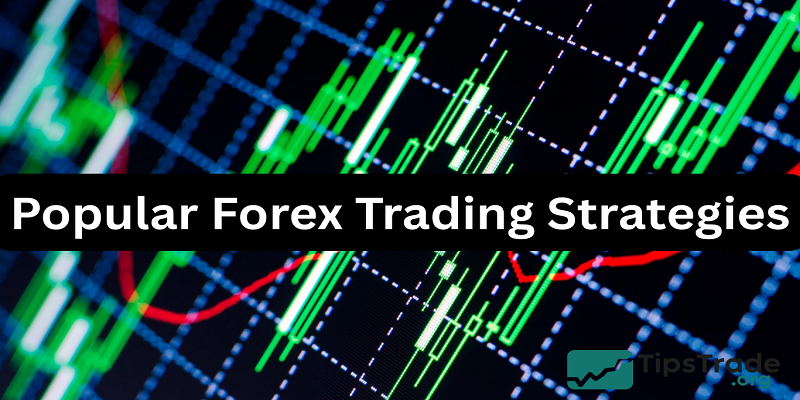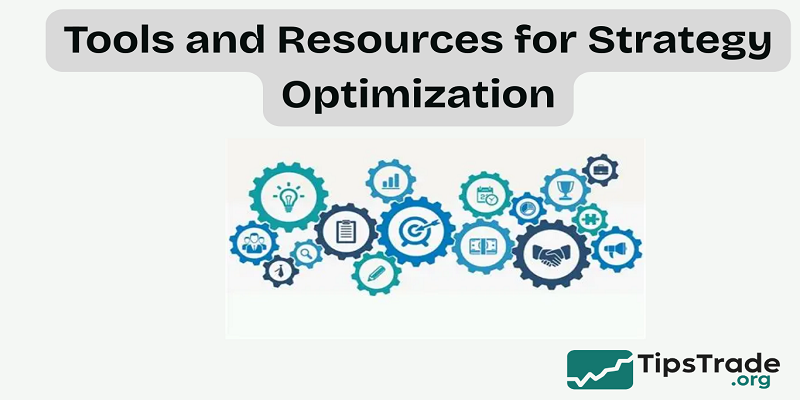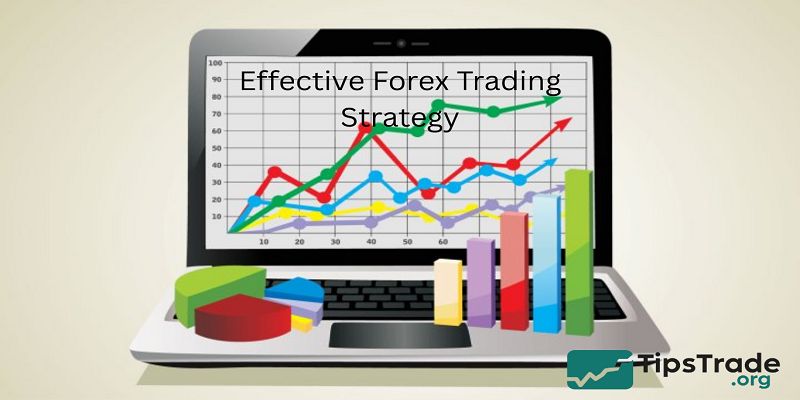Effective forex trading strategy is the foundation of success in the currency markets. While many beginners rush into trades without a clear plan, seasoned traders know that consistent profits come from discipline, proper risk management, and structured strategies. Forex is the most liquid financial market in the world, with daily trading volume exceeding $7.5 trillion according to the Bank for International Settlements (BIS, 2022). Through this article, let tipstrade.org follow details
What Makes a Forex Strategy Effective?

An effective forex trading strategy includes these detailed components in English:
-
Clear and Specific Rules: The strategy must define exact entry and exit points, including when to buy or sell currency pairs, supported by both technical and fundamental analysis. Rules for managing trades with stop-loss and take-profit levels are essential.
-
Risk Management: Managing risk is crucial to avoid large losses. Traders set a maximum percentage of capital to risk per trade, use stop-loss orders, and maintain favorable risk-to-reward ratios (e.g., 1:3). Position sizing and diversification help control exposure.
-
Consistency and Measurability: The strategy should produce consistent results that can be backtested on historical data and reviewed regularly. Consistency reduces emotional stress and prevents impulsive decisions.
-
Adaptability: The strategy should be flexible to adapt to changing market conditions and be regularly updated based on performance analysis.
-
Matching Trader’s Profile: It should align with the trader’s personality and schedule. For example, day traders are suited for fast-paced strategies like scalping, while swing traders may prefer longer-term trades.
-
Use of Technical Analysis Tools: Including moving averages, support and resistance levels, Fibonacci retracements, RSI, MACD, and candlestick patterns to identify trends and entry/exit points.
-
Incorporation of Fundamental Analysis: Monitoring economic indicators, interest rate decisions, and geopolitical events to anticipate market movements.
-
Focus on Specific Currency Pairs: Specializing in selected pairs to deepen expertise.
-
Use of Technology and Automation: Leveraging automated systems and machine learning to improve decision-making and execution.
-
Simple and Clear Trading Plan: Keeping the plan concise, with defined financial goals and risk tolerance, easy to follow without overcomplication.
Popular Forex Trading Strategies

Day Trading
- Day trading involves opening and closing positions within the same day, avoiding overnight exposure.
- It is attractive to traders who want quick results and dislike holding positions for long periods.
- Successful day traders focus on liquid currency pairs like EUR/USD or GBP/USD, which offer tight spreads and frequent price movements.
- They often rely on technical indicators such as moving averages, MACD, and RSI to find short-term opportunities.
- However, day trading requires discipline, fast decision-making, and the ability to handle stress.
- According to a study by the University of California, only about 10–15% of day traders are consistently profitable, which highlights the importance of strong risk management.
- Experienced traders often combine day trading with strict trading journals, reviewing what worked and what didn’t to refine their strategies.
Swing Trading
- Swing trading targets medium-term price moves, often lasting several days to weeks. Traders analyze both technical setups and fundamental factors, such as interest rate expectations or upcoming economic data.
- A swing trader might, for example, buy the U.S. dollar ahead of a Federal Reserve rate hike while also using chart patterns to identify entry points.
- Swing trading requires patience and the ability to hold positions through minor fluctuations.
- This style is considered more beginner-friendly than scalping or day trading, as it allows traders to make decisions without the pressure of intraday volatility.
- Studies show that many institutional traders favor swing strategies because they align with broader macroeconomic trends.
Scalping
- Scalping is one of the most intense strategies, where traders open dozens or even hundreds of trades in a single day, aiming to capture very small price movements.
- Scalpers usually trade on one-minute or five-minute charts, taking advantage of high liquidity during peak hours.
- The key to success in scalping is speed and execution. Traders often use direct market access brokers with ultra-low spreads.
- However, the risks are high: even small slippage or transaction costs can eat into profits.
- Scalping is not suitable for beginners, but experienced traders who thrive in fast-paced environments can achieve strong returns.
Position Trading
- Position trading is a long-term approach, where traders hold positions for weeks, months, or even years.
- This strategy relies heavily on fundamental analysis, such as interest rate differentials, geopolitical stability, and long-term economic trends.
- For example, a trader may buy the U.S. dollar against the Japanese yen if they believe the Fed will keep raising rates while the Bank of Japan maintains its ultra-low rates.
- Position trading requires significant patience and capital but is less stressful because it avoids constant monitoring of charts.
- It is often considered a professional strategy, favored by hedge funds and investment managers.
News Trading
- News trading focuses on taking advantage of volatility during major economic announcements, such as U.S. Non-Farm Payrolls or central bank rate decisions.
- The strategy can be profitable but also extremely risky, as spreads widen and prices can swing unpredictably.
- News traders often use pending orders placed before the event, anticipating breakout movements.
- For example, during Brexit negotiations, GBP/USD experienced massive volatility, providing opportunities for skilled traders who understood the risks.
- Success in news trading requires a deep understanding of both economic fundamentals and market psychology.
Key Elements of a Profitable Forex Strategy

Risk-to-Reward Ratio
- A profitable forex strategy balances risk and reward. Professional traders rarely risk more than 1–2% of their account on a single trade.
- By maintaining a positive risk-to-reward ratio, even a strategy with modest accuracy can be profitable.
- For example, risking 1% per trade with a 1:3 ratio means that only 4 winning trades out of 10 can generate overall profit.
Money Management
- Money management involves deciding how much to risk per trade and how to grow capital over time.
- Using tools like position size calculators ensures consistency.
- Traders often apply the “fixed fractional method,” risking a set percentage of capital per trade, which protects accounts from catastrophic losses.
Trading Psychology
- Psychology is often called the hidden edge in trading. Fear, greed, and impatience can sabotage even the best strategies.
- Traders who follow a clear plan and maintain discipline tend to perform better.
- Techniques like journaling trades, practicing mindfulness, and setting predefined rules help control emotions.
Consistency and Discipline
- Consistency turns strategies into long-term success. Instead of chasing every new indicator, effective traders test their systems and stick with them.
- Backtesting on historical data and forward testing on demo accounts provide confidence before risking real money.
How to Build Your Own Forex Strategy

- Define Goals: Are you aiming for quick profits or steady long-term growth?
- Choose a Style: Pick between scalping, day trading, swing, or position trading based on lifestyle.
- Select Indicators: Use tools like moving averages, RSI, or MACD.
- Incorporate Fundamentals: Track economic calendars, central bank decisions, and global events.
- Set Risk Rules: Define stop-loss, position size, and maximum daily loss.
- Test the Strategy: Backtest on past data and run on demo accounts.
- Track Results: Keep a journal to analyze wins and losses.
Building a strategy takes time, but the process itself develops trading discipline and self-awareness.
Common Mistakes to Avoid
-
Overtrading: Entering too many trades without valid setups leads to loss of capital and energy. Discipline in choosing trades is crucial.
-
Ignoring Risk Management: Many traders lose their accounts by risking too much on a single trade. Setting strict stop-loss orders and risking only a small portion of capital per trade (usually 1-3%) is essential.
-
Chasing Losses: Revenge or impulse trading after a loss causes emotional decisions and often bigger losses.
-
Lack of Testing: Trading untested strategies or using real money without practice increases the risk of failure. Using demo accounts to test strategies first is advisable.
-
Ignoring Psychology: Emotional control and discipline are vital. Without these, even profitable strategies fail.
-
Trading Without a Plan: A structured trading plan acts as a roadmap to guide decisions and prevent impulsive actions.
-
Using Excessive Leverage: Leverage can magnify profits but also losses. Overuse can lead to margin calls and big losses.
-
Trading Before Major News Events: High volatility can cause unpredictable price movements; it’s safer to avoid trading immediately before such events.
-
Not Analyzing Past Trades: Maintaining a trading journal to learn from mistakes and successes improves future performance.
Tools and Resources for Strategy Optimization

-
Economic Calendars: Websites like Forex Factory and Investing.com provide real-time updates on important economic data releases (e.g., inflation, employment reports) that impact currency markets, helping traders anticipate volatility and adjust strategies accordingly.
-
Trading Platforms: Popular platforms such as MetaTrader 4/5, cTrader, and TradingView offer extensive backtesting tools to simulate trading strategies on historical data. MetaTrader also supports automated trading with Expert Advisors (EAs), giving flexibility in strategy development and optimization.
-
Backtesting Software: Dedicated software like Forex Tester allows traders to test and optimize strategies by running simulations over historical price data. These platforms often include features to tweak parameters and find the most profitable settings.
-
Risk Management Tools: Risk calculators and position sizing tools help optimize the risk-reward ratio, ensuring trades fit within accepted risk limits.
-
Trading Journals: Keeping a journal to track trades enables reflection on what works and what needs adjustment, a key part of continuous strategy improvement.
-
Forex Simulators: Simulators let traders practice in real-time market conditions using virtual money to test and refine strategies without financial risk.
-
News Sources: Bloomberg, Reuters, and central bank websites provide essential market news and updates to incorporate into fundamental analysis.
-
Educational Resources: Websites like BabyPips, Investopedia, and many brokers’ webinars offer tutorials on trading concepts, technical/fundamental analysis, and strategy refinement.
-
Trading Communities: Forums, Discord groups, and social trading networks provide peer support, idea sharing, and feedback to improve strategies.
-
Advanced Tools: For algorithmic traders, platforms like QuantConnect and Python-based frameworks (e.g., Backtrader) enable coding and rigorous testing of automated strategies with access to vast historical data.
Using these tools ensures that strategies remain updated and adaptable to changing market conditions.
Conclusion
An effective forex trading strategy is more than just signals or indicators—it is a structured approach that balances technical analysis, fundamental insights, risk management, and psychology. The world’s most successful traders emphasize discipline, consistency, and adaptability. By choosing the right style, defining clear rules, and avoiding common mistakes, you can build a strategy that works for you. Remember, no strategy guarantees profits, but the right framework increases your chances of long-term success in the $7.5 trillion-a-day Forex market.

